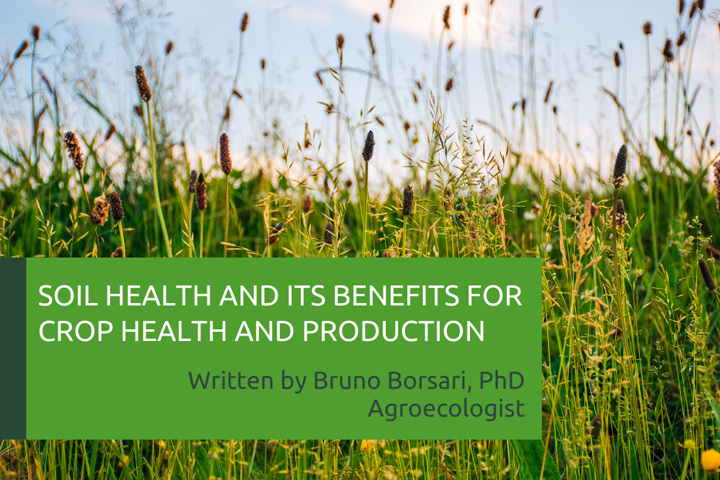Editor’s note: EarthScout® is passionate about helping growers develop and maintain healthy soils. Our experience indicates that maintaining a healthy and productive soil ecosystem will help growers to produce quality crops and increase yields, while also caring for the environment. We are pleased to partner with Bruno Borsari, in our effort to foster knowledge and restoration practices to reclaim life in the soil.
What is soil health and what makes it “healthy”?
Soil health has become a topic of great interest among farmers and ranchers these days. Soil health fosters soil quality, and this allows an achievement of consistent, desirable crop yields, without relying much on off-farm inputs.
The concepts of soil health and soil quality are intertwined and although soil quality refers to the capacity of the soil to be productive, a soil will be healthy when its management and cultivation will increase the diversity of organisms that live in it.
A soils’ community of decomposers (earthworms, springtails, grubs, algae, fungi, and bacteria to name a few) break down complex, carbon-rich molecules produced by plants (root exudates, biomass, or crop residues left in the field after the harvest) and convert these into humus, which is the stable form of soil organic matter (SOM). This process is very important in conserving soil quality and supporting life in the soil.
YES! The soil is a living system and its biology plays a pivotal role in maintaining its fertility. A soil’s biological diversity and metabolism improve its physical-chemical characteristics, supporting healthy crops, healthy animals, and ultimately healthy people!
Why reliance on fertilizers is a problem:
The manufacturing and wide use of synthetic fertilizers since the early 20th century yielded initially impressive results because plants responded beautifully to N-P-K nutrients ready for uptake. However, the use of synthetic fertilizers requires irrigation to maximize plants’ growth and their luxuriant development to be most effective.
When plants receive fertilizer, most will require more chemicals (pesticides) because when plants are fertilized, they become very attractive to insect pests through altered nutrient levels in plants’ tissues. Also, fertilized crops attract weeds, making necessary the use of herbicides to keep unwanted plant populations at bay.
The use of agrichemical products in agriculture has been proven to reduce soil biological diversity, leading to a cascade effect of consequences (environmental and economic) that will trap producers in a treadmill, from which it becomes harder and harder to manage without using chemical inputs.
The loss of soil biological diversity is directly correlated to a loss of humus (SOM), which eventually leads to more losses of soil microorganisms. Long term use of synthetic fertilizers also increases salinity in soils which, amplified by erosion, determines more loss of soil and pollution of water sources.
The loss of soil health deteriorates its quality, although a continuous use of chemical inputs may give the illusion that the land is doing great (crop yield being the only indicator).
What you can do to increase soil health:
Initiating a “detoxification program” of your land by reducing the use of agrichemical products supported by agronomic practices that are more integrative and sustainable produces significant gains for a reestablishment of soil health (Fig. 1). A restoration of the farm’s physiology begins with a rehabilitation and maintenance of its soil health.

A sustainable management of crop residues is key to a restoration of health in the soil because residues are the carbon-rich “feed” that sustain the soil food-web.
Farm animals are very valuable in this process because their manure and urine will enrich the residues and facilitate the humification process.
Cover cropping is priceless to protect the soil from erosion and it contributes to the soil organisms’ health by adding more diverse biomass for these to digest.
Tillage should be reduced as much as possible because it contributes to erosion, soil compaction, and loss of water retention, SOM and pore space. These physical traits are so important to life in the soil!
An employment of trees and other perennial plants can only be beneficial to minimize tillage and foster soil health, a step further, while increasing the diversity of plants community above ground.
Crop rotations are key to a diversification of crop residues and this diversity will foster diversity of life in the soil.
In summary, increasing agrobiodiversity above and below ground and decreasing your reliance on synthetic chemical use will boost your soil health!
Dr. Bruno Borsari is an Agroecologist and Professor Emeritus of Biology at Winona State University. His published works can be found on researchgate.net or the following link: https://www.researchgate.net/profile/Bruno-Borsari
Editor’s note: You can use remote soil sensors such as EarthScout for monitoring your soil health. Products like EarthScout measure soil temperature, moisture, EC and other factors to help you establish and maintain living soils, where a diversity of organisms can thrive and contribute to your crops’ health. Learn more at: www.earthscout.com.
